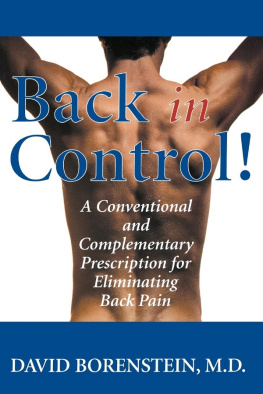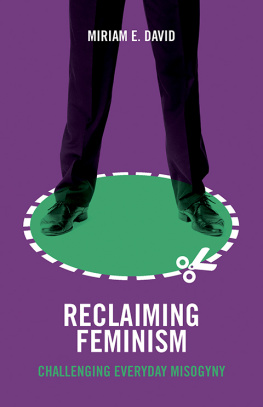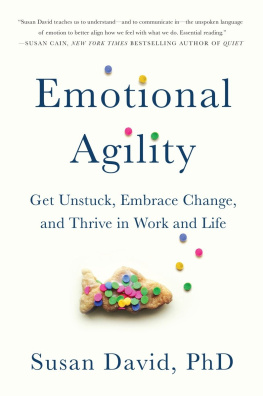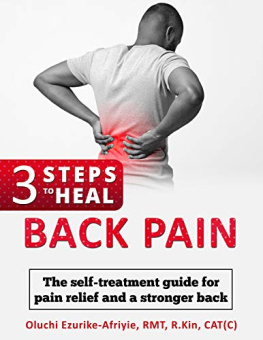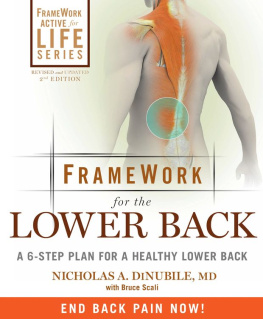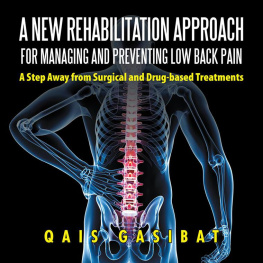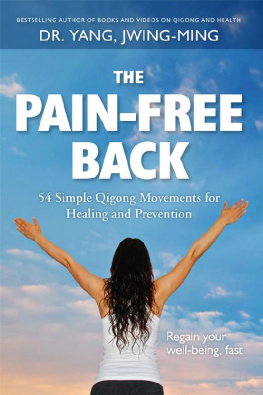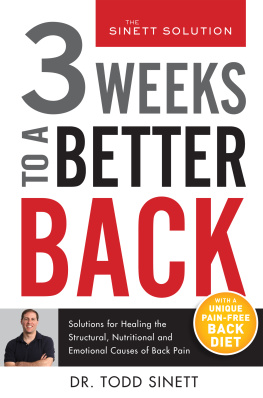David - Back in Control: Your Complete Prescription for Preventing, Treating, and Eliminating Back Pain from Your Life
Here you can read online David - Back in Control: Your Complete Prescription for Preventing, Treating, and Eliminating Back Pain from Your Life full text of the book (entire story) in english for free. Download pdf and epub, get meaning, cover and reviews about this ebook. year: 2003, publisher: M. Evans & Company, genre: Science. Description of the work, (preface) as well as reviews are available. Best literature library LitArk.com created for fans of good reading and offers a wide selection of genres:
Romance novel
Science fiction
Adventure
Detective
Science
History
Home and family
Prose
Art
Politics
Computer
Non-fiction
Religion
Business
Children
Humor
Choose a favorite category and find really read worthwhile books. Enjoy immersion in the world of imagination, feel the emotions of the characters or learn something new for yourself, make an fascinating discovery.
- Book:Back in Control: Your Complete Prescription for Preventing, Treating, and Eliminating Back Pain from Your Life
- Author:
- Publisher:M. Evans & Company
- Genre:
- Year:2003
- Rating:5 / 5
- Favourites:Add to favourites
- Your mark:
- 100
- 1
- 2
- 3
- 4
- 5
Back in Control: Your Complete Prescription for Preventing, Treating, and Eliminating Back Pain from Your Life: summary, description and annotation
We offer to read an annotation, description, summary or preface (depends on what the author of the book "Back in Control: Your Complete Prescription for Preventing, Treating, and Eliminating Back Pain from Your Life" wrote himself). If you haven't found the necessary information about the book — write in the comments, we will try to find it.
Back in Control: Your Complete Prescription for Preventing, Treating, and Eliminating Back Pain from Your Life — read online for free the complete book (whole text) full work
Below is the text of the book, divided by pages. System saving the place of the last page read, allows you to conveniently read the book "Back in Control: Your Complete Prescription for Preventing, Treating, and Eliminating Back Pain from Your Life" online for free, without having to search again every time where you left off. Put a bookmark, and you can go to the page where you finished reading at any time.
Font size:
Interval:
Bookmark:
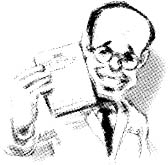
David Borenstein, M.D., is clinical professor of medicine and former medical director of the Spine Center and the George Washington University Medical Center. Dr. Borenstein is a board-certified internist and rheumatologist who is internationally recognized for his expertise in the care of patients with back pain and spinal disorders.
Dr. Borenstein received his undergraduate degree from Columbia University in 1969. His medical school, internal medicine residency, and rheumatology fellowship training were completed at the Johns Hopkins University Medical School and Hospital from 1969 to 1978. he became an assistant professor of medicine at the George Washington University Medical Center in 1978. He was promoted to professor of medicine in 1989. He became a clinical professor of medicine on the voluntary faculty in 1997.
Dr. Borenstein is an author of a number of medical articles and books, including Low Back Pain: Medical Diagnosis and Comprehensive Management (2nd ed.). This book has been recognized by the Medical Library Association Brandon/Hill list as one of the 200 essential books for a medical library. He is also author of Neck Pain: Medical Diagnosis and Management. He has lectured to the general public on behalf of the Arthritis Foundation on a wide variety of medical topics. He has chaired low back pain symposia for a number of physician groups, including the American College of Rheumatology. He has also moderated national telesymposia sponsored by pharmaceutical companies for physicians. He has also served as a medical guest expert for CNN and local news programs.
Dr. Borenstein is a fellow of the American College of Physicians and American College of Rheumatology. He is a member of the International Society for the Study of the Lumbar Spine and is listed in The Best Doctors in America, Year 200 Edition. He is included in Whos Who in Medicine and Healthcare, 2nd edition and Whos Who in America, 54th edition. He is in active clinical practice in Washington, D.C.
I want to thank the individuals who have been willing to lend support, encouragement, and expertise in the development and review of this book:
Arthur Frank, M.D., medical director of the Weight Management program at the George Washington University Medical Center, for his thoughtful comments concerning the food and nutrition sections of this book.
John Starr, M.D., orthopaedic surgeon, for offering his expertise in reviewing the surgical components of this book.
Tom Welsh, R.P.T., physical therapist, for his generosity and friendship in allowing his exercise program to be included in this book.
Virginia McCullough, for organizing my first manuscript proposal, finding my book agent, and helping me with my first draft.
Marian Betancourt, for helping me with my final draft of this book.
Nancy Love, my literary agent, for having confidence in me and finding a company to publish my book.
Judy Guenther, illustrator, for taking my ideas and drawing illustrations that make understanding much easier.
PJ Dempsey, my editor at M. Evans, for guiding me through the beginning, middle, and end of a very long process that has resulted in the publication of this book.
My partners at Arthritis and Rheumatism AssociatesJohn Lawson, M.D.; Werner Barth, M.D.; Norman Koval, M.D.; Herbert Baraf, M.D.; Robert Rosenberg, M.D.; Evan Siegel, M.D.; Emma DiIorio, M.D.; and Sheila Kelly, M.D.for being supportive and understanding during the development and production of this book.
BACK SCHOOL FAQ
In the late 1960s, a Swedish physical therapist, Maryanne Zachrisson-Forssell, developed a sound-slide program that included basic information about low back pain. The four one-hour sessions included information of anatomy and function of the spine, body mechanics, and exercise programs. The classes also included question-and-answer sessions to address any issues that were not addressed during the slide lectures.
The enthusiasm for back schools in the United States slowly increased over time. Physicians, physical therapists, and nurse specialists teach the courses. Back schools exist in medical schools, community hospitals, YMCAs, and industrial settings.
The methods of teaching vary at back school depending on the philosophy of the organizers. Students may be given classroom instruction, or demonstrations of exercises and work habits, or motivation. Teaching methods vary around the world. The Swedish Back School is designed as a general information program with an exercise program to improve physical conditioning. The Canadian Back School uses psychological approaches to increase self-awareness about pain and function. The role of anxiety and stress is emphasized. The California Back School teaches how to control acute low back pain. Individuals go through an obstacle course to measure physical function. Instruction over a three-week period improves physical function.
Do back schools help people prevent recurrences of back pain? A study was conducted in a Volvo car plant where back school instruction was matched against back exercises or heat therapy. Employees who attended back school had fewer days off work than the other two groups.
When I was the director of the Spine Center at the local medical center, I helped organize their back school. A number of back pain sufferers became students at the school. The instructors of the classes had an opportunity to compile a number of questions that were repeatedly asked at the back school sessions. Here are some of the most frequently asked questions and my most current answers.
You would think that with as much time as people have been sleeping on beds I would have the answer to this question. What seems to be clear is that preferences are as numerous as the people who go to sleep every night.
When I began my professional career, I thought only a rock-hard bed would be best for back pain patients. Over the years, I have learned that what may be good for a person on one side of the bed may not be so good for the other. How do you solve this dilemma?
There are a few ways of testing what makes your back better before buying a bed. The back, between the pelvis and the shoulders, is like an upside-down suspension bridge. The supports for this semicircle are the buttocks and shoulders. The firmer the bed, the more the supports will stay above the water and keep tension in the back, maintaining the lumbar curve, or lordosis. The softer the bed, the more the supports will sink, placing less tension on the lumbar spine, causing it to lose the lordosis, or flatten.
The more you want to maintain a lumbar curve, the firmer the mattress you want. If you want to test this idea, try sleeping on a few blankets or an exercise mat on the floor for a few nights. If your back feels rested, a hard mattress is for you. If you prefer a flat back, a softer mattress will do.
Another way to test this idea is by testing what effect the position of your legs has on your pain. If you prefer to have your legs flat on the bed, you will prefer a hard mattress. If you prefer your knees bent, you will prefer a mattress with more padding.
These suggestions are starting points to decide on your personal preference. You will be sleeping on the bed and need to decide if it will be restful to you. Do not be bashful. Go to the mattress store and test out the merchandise. Rest on them for twenty to thirty minutes to feel if they are comfortable. Having some medical name (chiropractic, orthopaedic) associated with the name of the bed does not guarantee that the bed will be good for you. The only way to know is to test it out.
Font size:
Interval:
Bookmark:
Similar books «Back in Control: Your Complete Prescription for Preventing, Treating, and Eliminating Back Pain from Your Life»
Look at similar books to Back in Control: Your Complete Prescription for Preventing, Treating, and Eliminating Back Pain from Your Life. We have selected literature similar in name and meaning in the hope of providing readers with more options to find new, interesting, not yet read works.
Discussion, reviews of the book Back in Control: Your Complete Prescription for Preventing, Treating, and Eliminating Back Pain from Your Life and just readers' own opinions. Leave your comments, write what you think about the work, its meaning or the main characters. Specify what exactly you liked and what you didn't like, and why you think so.

